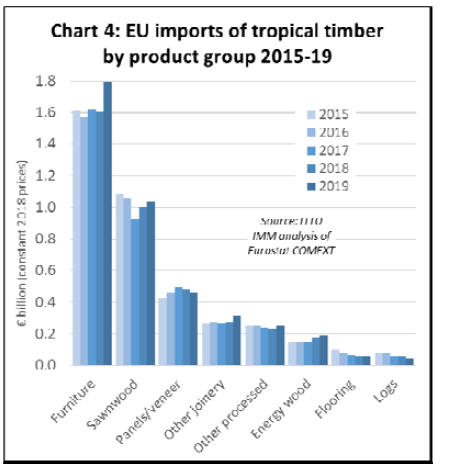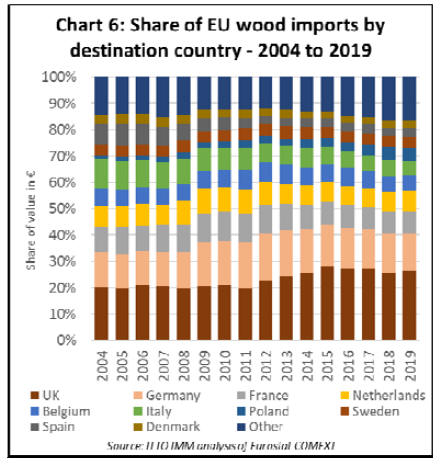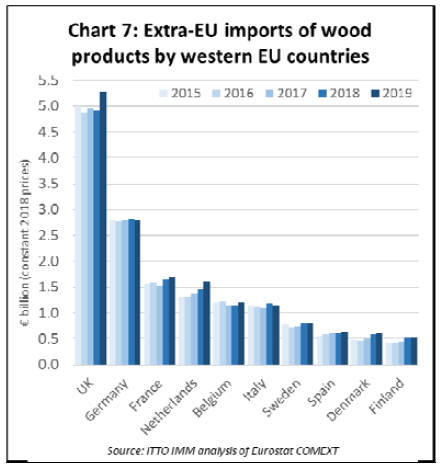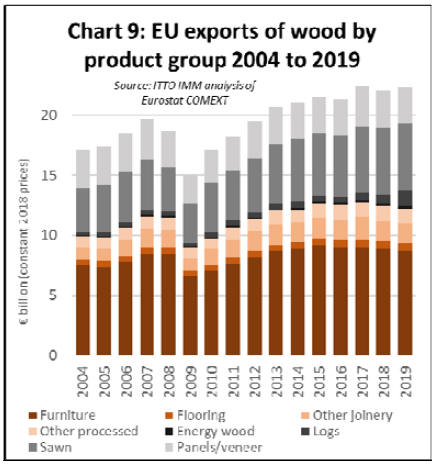|
Report from
Europe
Recovery in EU wood imports continues in 2019
The total value of EU28 imports of wood products was
20.51 billion euro in 2019, 4% more than in 2018. This
followed an increase of 5% to 19.7 billion euro in 2018. In
2019 EU28 import value was at the highest level since
2008 just before the global financial crises (Chart 1).

The rise in imports into the EU occurred despite
unfavorable exchange rates and weakening economic
growth during 2019, particularly in the second half of the
year. According to the EU Winter 2020 Economic
Forecast published on 13 February, GDP growth in the
EU27 (i.e. excluding the UK) slipped to 1.5% in 2019,
down from 2.1% in 2018. A further slight fall to 1.4% is
projected for 2020.
The slowing economy fed through into a 4% decline in the
value of the euro against the U.S. dollar last year
following an 8% fall the previous year. The British pound
dipped to an all-time low against the US dollar and other
top currencies in the middle of 2019 as concerns mounted
over Brexit, although it did rally to some extent towards
the end year.
On the other hand, EU currencies remained reasonably
strong relative to currencies in several key Eastern
European supply countries, including Ukraine, Russia, and
Turkey. These exchange rate fluctuations generally
favored EU imports from Eastern Europe and acted as a
drag on imports from North America and Asia.
Slow economic growth expected to continue in the EU
Looking to the future, the EU¡¯s Winter Forecast suggests
that the ¡°external environment remains challenging¡± but
that ¡°continued employment creation, robust wage growth,
and a supportive policy mix should help the European
economy maintain a path of moderate growth¡±. In a
positive note for the timber sector, the Forecast also
suggested that ¡°private consumption and investment,
particularly in the construction sector, will continue to fuel
economic growth¡±.
It was also noted that ¡°the European economy could
benefit from more expansionary and growth-friendly fiscal
policies and enjoy positive spillovers from more benign
financing conditions in some euro area Member States¡±.
However, the Forecast also suggests that ¡°overall the
balance of risks continues to remain tilted to the downside.
The ¡®Phase One' trade deal between the US and China has
helped to reduce downside risks to some extent, but the
high degree of uncertainty surrounding US trade policy
remains a barrier to a more widespread recovery in
business sentiment.¡±
The outbreak of the ¡®2019-nCoV' coronavirus, with its
implications for public health, economic activity and trade,
especially in China, is identified in the Forecast as a new
downside risk. ¡°The baseline assumption is that the
outbreak peaks in the first quarter, with relatively limited
global spillovers. The longer it lasts, however, the higher
the likelihood of knock-on effects on economic sentiment
and global financing conditions¡±.
On Brexit, the Forecast notes that ¡°While there is now
clarity on trading relations between the EU and the United
Kingdom during the transition period, there remains
considerable uncertainty over the future partnership with
the UK¡±.
As a forward-looking report, the EU Winter 2020 Forecast
excludes the UK which ceased to be an EU member on
31st January 2020 (although the UK is still subject to EU
regulations until the end of the transition period on 31st
December 2020).
For data on the UK, it is now necessary to look to the UK
Office of National Statistics (ONS), which reports that the
UK economy saw no growth in the final three months of
2019, as manufacturing contracted for the third quarter in
a row and the service sector slowed around the time of the
election. The ONS figures showed the UK economy grew
by 1.4% in 2019, marginally higher than the 1.3% rate in
2018.
More positively, ONS data shows that the UK economy
expanded 0.3% in December compared with the previous
month, better than expectations. This, combined with
recent sentiment indicators, suggests the UK economy has
picked up since the general election on 12th December.
EU wood furniture imports rise 10% in 2019
Considering individual products (Chart 2), the value of EU
imports of wood furniture increased by 10% to 7.07 billion
euro in 2019 after a 1% fall in 2018. After flat lining in
2018, imports from China, the EU¡¯s largest external
furniture supplier, increased throughout 2019.
Imports from Turkey, the second largest external supplier,
also made some gains, but not as large as those made by
several tropical suppliers including Indonesia, Vietnam,
Malaysia and India. Furniture imports from Bosnia were
weakening throughout the year, but imports from Serbia
were rising.

EU imports of sawn wood declined 2% to 3.57 billion euro
in 2019, losing some of the gains made the previous year
when imports increased 10%. After a strong first quarter,
sawn wood imports slowed dramatically from April 2019
onwards.
During this period, the pace of sawn wood imports fell
rapidly from all four of the leading suppliers, Russia,
Belarus, Ukraine, and the United States. Of tropical sawn
wood suppliers, imports from Cameroon and Brazil
increased, partly offset by a continuing fall in imports
from Malaysia.
EU imports of panels (mainly plywood) decreased 9% to
2.83 billion euro in 2019, wiping out the 8% gain made the
previous year and the first fall in imports of this
commodity for 6 years. Imports from Russia and Belarus,
which experienced particularly dramatic growth in
previous years, slowed throughout 2019.
Imports from China finished the year 2019 up on the
previous year but were weakening in the second half of
2019. Imports from nearly all the other main suppliers ¨C
including Brazil, Ukraine, Chile and the US ¨C were
weakening during 2019. Indonesia fared better than most,
a strong rise in plywood imports from the country in the
first half offsetting a slow down towards the end of the
year.
The long-term rise in EU imports of energy wood
continued in 2019 with annual import value rising 13% to
2.84 billion euro building on 20% growth the previous
year. There was another sharp increase in EU imports of
energy wood from the United States in 2019 (now
dominated by pellets), to reach nearly 1.3 billion euro,
with most destined for the UK. Imports of energy wood
also increased sharply from Russia, to nearly 0.5 billion
euro, and Belarus, mainly destined for continental EU.
Imports were stable from Canada and Ukraine.
EU imports of logs declined 9% to 660 million euro in
2019, after rising 3% the previous year. The downturn was
due partly to a slowdown in imports from Russia in the
second half of 2019, while all EU imports of logs from
Belarus ceased in 2019 after tightening of log export
controls in the country.
After rising 3% in 2018, EU imports of wood flooring
made another 3% gain to 610 million euro in 2019.
Flooring imports from China, by far the largest external
supplier accounting for around two thirds of the total,
continued to rise strongly in the first half of 2019 but
began to lose ground in the second half of the year, while
imports from Ukraine continued to make gains throughout
2019. Imports from Switzerland, Malaysia and Indonesia
were sliding throughout the year.
EU imports of ¡®other¡¯ joinery products (i.e. excluding
flooring and mainly comprising doors and laminated wood
for window frames and kitchen tops) increased 12% to 800
million euro in 2019, after flat lining the previous two
years. There was particularly strong growth in imports of
this commodity group from Indonesia, building on gains
made in the previous year, while imports from China and
Malaysia also made ground.
Recovery in EU imports from China
The total value of EU imports from China increased 6%
from 5.34 billion euro in 2018 to 5.71 billion euro in 2019,
mainly due to a partial recovery in imports of Chinese
furniture, and to a lesser extent joinery products and
plywood. After falling between 2015 and 2018, China¡¯s
share in total EU imports of timber products recovered
from 27.1% in 2018 to 27.8% last year (Chart 3).

After several years of rapid growth, EU imports of wood
products from CIS countries increased only 1% in 2019,
rising from 4.71 billion euro in 2018 to 4.74 billion euro
last year.
The share of CIS countries in total EU imports declined
from 23.9% in 2018 to 23.1% in 2019. The growth in
imports from Russia, Ukraine and Belarus all began to
slow last year. The slowing trend was apparent in imports
of sawnwood, plywood and logs from the CIS region.
However, EU imports of CIS energy wood and furniture
products continued to rise in 2019.
EU imports from non-EU European countries remained
flat, at 2.08 billion euro, in 2019 and share of imports from
these countries also remained level at just over 10%.
While imports from Bosnia and Herzegovina, Norway and
Switzerland slowed last year, imports from Serbia and
North Macedonia were rising.
EU imports from North America increased 4.3% from
2.30 billion euro in 2018 to 2.4 billion euro in 2019. The
region¡¯s share of total EU imports remained flat at 11.7%
during this period. Rising imports of pellets, and to a
lesser extent barrels, offset declining imports of
sawnwood, furniture, and veneers from North America.
The vast majority of EU imports from North America are
now from the United States and only small proportion
from Canada.
EU imports of tropical wood products up 7% in 2019
The total value of EU imports of tropical timber products
(including direct imports and imports via third countries
such as China) increased 7% to 4.16 billion euro in 2019.
This follows a 2% increase in import value in 2018.
The share of tropical timber in the total value of EU wood
product imports increased from 19.7% in 2018 to 20.3% in
2019, rebounding to the level of two years earlier.
Considering the long-term trend, after falling continuously
from 36% in 2006 to 22% in 2013, the share of tropical
countries in EU imports stabilized in the range 20-22%
during the six years between 2014 and 2019.
The increase in the total value of EU wood product
imports from the tropics in 2019 was driven mainly by
wood furniture with other smaller gains in imports of
tropical sawnwood, ¡®other¡¯ (i.e. non-flooring) joinery,
other processed wood products, and energy wood. These
gains offset a decline in imports of tropical panels/veneers,
flooring and logs (Chart 4).
In 2019, there was a 10% increase in EU imports of wood
furniture from tropical countries, from 825 million euros
to 904 million euros. Imports of tropical sawnwood
increased 3% during the year, from 1,006 million euros to
1,040 million euros, building on the recovery of the
previous year.
There was also a sharp 16% increase in EU imports of
¡®other¡¯ joinery products from tropical countries in 2019,
from 273 million euros to 316 million euros, with good
growth in imports of tropical doors and laminates. Imports
of energy wood, mainly charcoal, also increased, by 8%
from 177 million euros to 191 million euros. However, EU
imports of tropical logs, panels/veneers, and flooring were
either flat or declining in 2019.

The value of EU imports from the two leading tropical
suppliers, Indonesia and Vietnam, increased sharply in
2019, both benefitting from a significant increase in
shipments of wood furniture.
Imports from Indonesia increased 10% from 825 million
euros in 2018 to 904 million euros in 2019. Imports from
Vietnam increased 8% from 822 million euros to 890
million euros during the same period.

During 2019, there were also significant gains in EU
imports from India (by 12% to 339 million euro, mainly
furniture), Brazil (by 16% to 271 million euro, mainly
hardwood sawnwood and decking), Cameroon (by 5% to
268 million euro, mainly sawnwood), and Congo (by 17%
to 93 million euros, mainly sawnwood).
However, imports from Malaysia fell slightly, by 1% to
531 million euros last year, with gains made by Malaysian
furniture offset by a sharp fall in EU imports of Malaysian
sawnwood. EU imports from Côte d'Ivoire also continued
to decline in 2019, losing another 9% to only 61 million
euros.
One quarter of EU wood imports destined for the UK in
2019
In 2019, the UK was by far the largest importer of wood
products into the EU from outside the bloc, highlighting
the impact of Brexit on the EU¡¯s position in the global
wood products trade. The UK¡¯s share of total EU imports
of timber products from outside the region increased from
24.9% in 2018 to 25.7% in 2019, reversing a slight
downward trend of the previous year. (Chart 6).

UK imports from outside the EU increased by 7% from
4.92 billion euro to 5.3 billion euro in 2019. The UK was a
significant recipient of rising EU imports of wood
furniture from China and Vietnam and pellets from the
United States in 2019. The Netherlands was the only other
Western European country to experience significant
growth in imports of wood products from outside the EU
last year, experiencing a significant rise in imports of
wood furniture from China and Indonesia (Chart 7).

Meanwhile several Eastern EU countries continued to
record quite large and consistent gains in imports from
non-EU countries last year. Significant increases were
recorded in Poland, Lithuania, Latvia, Slovenia, Czech
Republic, Croatia, Hungary, Bulgaria, and Slovakia in
2019. However, imports into Romania and Estonia slowed
in 2019 after making gains the previous year (Chart 8).

The continuing strength of Eastern European imports is a
reflection both of their proximity to large external
suppliers in Russia, Ukraine and Belarus, relatively higher
rates of economic growth and construction sector growth
in Eastern Europe, and the establishment of new wood
processing and manufacturing capacity in the region.
Slow growth in EU wood product exports in 2019
In 2019, the EU exported wood products with a total value
of 22.3 billion euro, a 1% increase compared to 2018 (22.1
billion euro) but below 2017 (22.4 billion euro) when
exports were at record levels (Chart 9).
Although EU exports of wood furniture, sawnwood,
panels, and ¡®other¡¯ joinery products, this was offset by a
rise in exports of energy wood, flooring, other processed
products and, particularly notable, a sharp increase in log
exports, much of it comprising softwood and destined for
China.

The combined effect of last year¡¯s large rise in EU
imports, balanced by a more moderate growth in EU
exports, was to reduce the EU¡¯s trade surplus in timber
products with the rest of the world from 2.37 billion euro
in 2018 to 1.81 billion euro last year. Longer term, the
EU¡¯s trade surplus in wood products has now fallen by
70% since 2013 (when it stood at over 6 billion euro) as
growth in EU imports has outpaced exports.
|